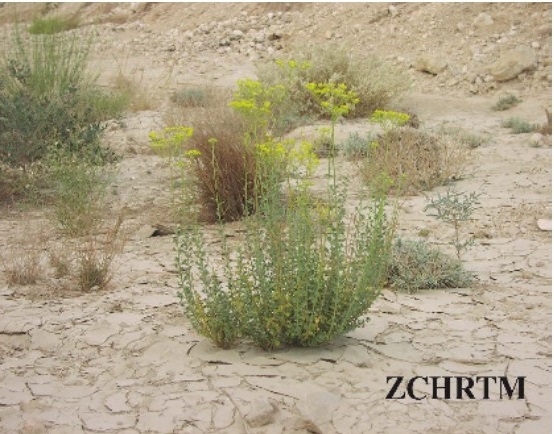
Ruta chaleepensis / السذاب
R.bracteosa(DC), R.angustifolia(Pers), R.chalepensis var bracteosa (DC.)Bioss., R.graveolens(L) var.angustifolia Hook.f.
Sadab, Seidhab, Shadhab, Shathab, Alkhatf,Fidjel,Rusta Bou ghans.
Herb of Grace
Seithab, Faijin
Rutaceae
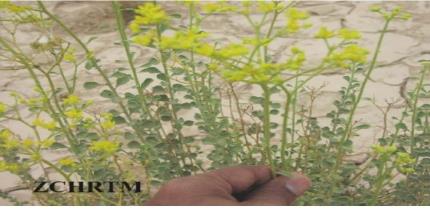
Flowering Branches
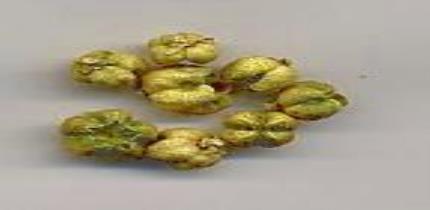
Seeds
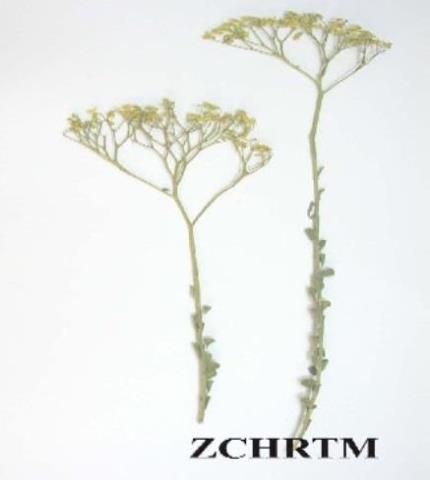
Herbarium Sample
Ethnobotanical Characteristics
Description
A evergreen perennial herb, somewhat woody below, strongly aromatic, erect to ascending, up to 50-80(100) cm high. Leaves silvery blue-green, alternate, oblong, pinnately divided into lanceolate lobes, with dentate margin. Small yellow flowers, c. 12mm across, in terminal corymbs; petals with fringed margins. Fruit sub globose capsule, 7-8mm, divided about half-way to base into 4-5 acute lobes. Seeds reniform, transversely wrinkled, tuberculate.
Habitat & Distribution
This ancient medicinal plant found in tropical & sub tropical regions of the world, commonly grown to Africa, Western Asia, Mediterranean Europe. In UAE it is found in Northern Emirates during rainy seasons.
Part(s) Used
Aerial parts
Traditional & Medicinal Uses
The plant is bitter, acrid, abortifacient, anthelmintic, emmenagogue and ophthalmic; antipyretic, analgesic, anti-inflammatory, antiseptic, irritant, expectorant, carminative, antispasmodic, stimulant. Infusion of plant is useful in infantile convulsions, bronchitis, jaundice, toothache, earache, stomachache, typhoid, rheumatic fever, intestinal problems, colds, earache and as gargle. A decoction of the plant has been used in the treatment of paralysis, coughs, stomachaches and as ophthalmic and vulnerary. Leaves and seeds boiled with oil and used topically for rheumatism, sprains, blood circulation and swellings. Fumigation by leaves for catarrh and cough in children. The leaves have been heated then placed inside the ear to treat earache. An essential oil obtained from the leaves is used in perfumery, food flavoring, for epilepsy and against scorpion and snake bites. The leaves are used as a condiment, added in very small amounts only, to salads and sandwiches. Flowering branches used as vulnerary, emmenagogue and as anti-spasmodic. Dried leaves are often used in wreaths and other decorations. Pregnant woman should not eat rue. Handling the plant, especially when in bloom, can cause skin irritation.
Pharmacognosy and Phytochemistry
Parts studied
Leaves & Stem
Microscopical Description
Leaf: A transverse section of the leaf shows that it is unilateral. The upper epidermis consists of papillose cells covered by a slightly striated thick cuticle. The palisade tissue is composed of two layers of compactly packed longitudinal cells with straight thick cell walls and they contain some coloured particles. The spongy mesophyll cells are oblong and some of these cells contain single cluster crystals of calcium oxalate. The spongy tissues also embed large glands and they are also traversed by angular vascular tissues that contain spirally and reticulately thickened vessels. The lower epidermis consists of small oval or rounded cells covered with raised thick cuticle but the cells are not papillose. The lower epidermis bears almost round anomocytic stomata that are fairly distributed.
Stem: the powder shows long compactly packed lignified fibers with thick walls and large lumens. It also shows large groups of compactly packed vascular tissues with their vessels reticulately and spirally thickened. (DPS, ZCHRTM unpublished results).
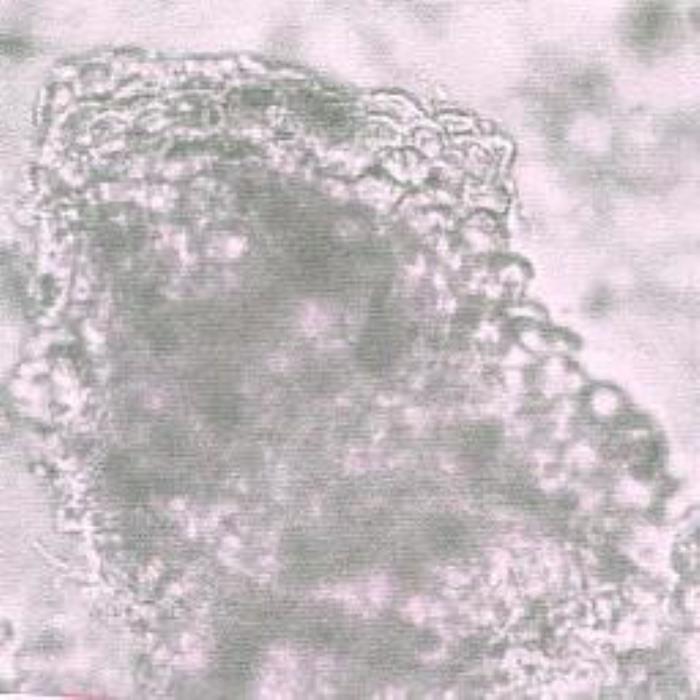
a) Upper epidermis
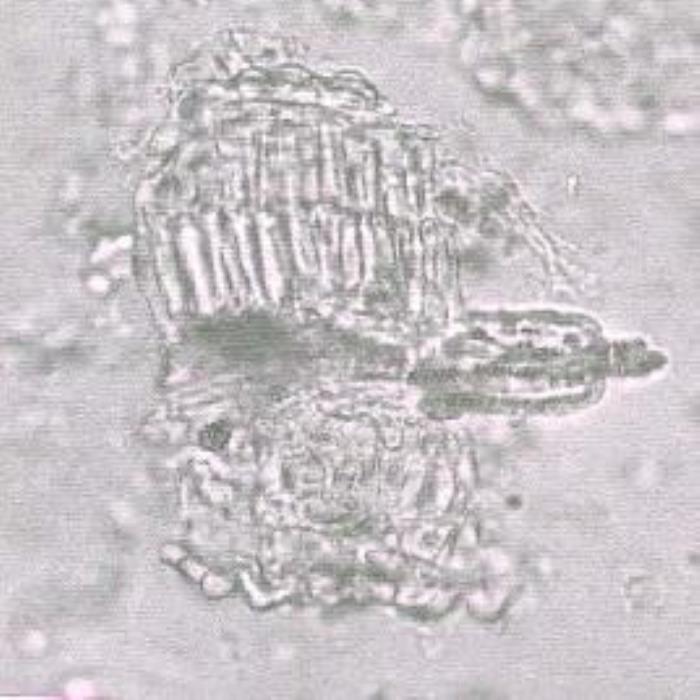
b) T S of leaf
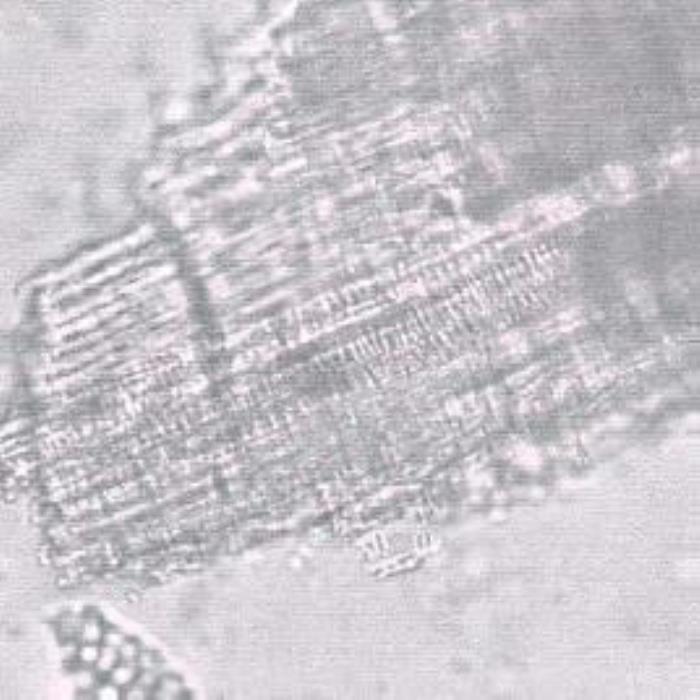
c) Fragment of stem
- (a). A fragment of the leaf showing the papillose cells of the upper epidermis.
- (b). TS of a portion of a leaf showing the papillose upper epidermis, the two layers of the palisade tissues, the spongy mesophyll cells (some containing calcium oxalate cluster crystals), embedded vascular tissues, and rounded or oval lower epidermal cells.
- (c). A fragment of the stem showing long compactly packed fibers with thick cell walls and large lumens surrounding a group of vascular tissues with their vessels reticulately and spirally thickened ( Magnifications: All x 250).
Organoleptic characteristics
Appearance: Powder
Colour: Light gray
Odour: Aromatic
Taste: Tasteless
Physicochemical constants
Loss in weight on drying at 105°c (%): 9.20-9.60
Solubilities (%)
Alcohol solubility: 6.40
Water solubility: 27.20
10% ethanolic extractive: 40.10
Ash values (%)
Total ash: 13.20-14.00
Water soluble ash: 2.40-2.60
Acid-insoluble ash: 0.20-0.40
Successive extractive (%)
Petroleum ether (60-80°c): 3.00
Chloroform: 2.6
Absolute alcohol: 10.80
Distilled water: 18.50
pH values
pH of 1% solution : 5.92
pH of 10% solution : 5.25
The above results are under process of publication( DPS, ZCHRTM unpublished results).
Chemical constituents
Alkaloids and coumarins, flavonoids and lignans (Ghazanfar 1994, DPS, ZCHRTM unpublished results).
Pharmacological and Toxicological studies
Ruta chelpensis showed antispasmodic effect and stimulates nervous system. The oil is used as anti helminthic, antispasmodic and anti-epileptic, emmenogogue, antiinflammatory and antibacterial activity Al-Okbi et al., 2002 ; Alzoreky and Nakahara, 2003).The leaves yielded two furanocoumarins, one quinoline alkaloid, and four quinolone alkaloids, showed anti-fungal activity. The anti-mycotic activity was observed in vitro experiment on the strains of Candida albicans isolated from clinical samples obtained in the course of acute vaginitis (Oliva et al., 2003). Ruta graveolens also showed anti-mycotic activity (Trovato et al., 2000).Dried leaf infusions of Ruta chelpensis were found to cause perinatal changes in mice, at daily doses of 0.16, 0.80 and 1.60 g/kg, administered p.o. from 1 to 14 days post coitum, showing embryotoxic effects (Zeichen et. al., , 2000).Acute (24-h) and chronic (90-day) oral toxicity studies on the ethanolic extracts of Foeniculum vulgare fruits and Ruta chelpensis aerial parts, carried out in mice, revealed a significant fall in RBC level in treated animals (Shah et. al., 1990).A commercial tincture prepared from Ruta exhibited a moderate photo-mutagenicity in an arginine-requiring mutant strain of Chlamydomonas reinhardtii (Schimmer and Kuhne, l990). Mutagenicity testing of a commercial extract from Ruta herba revealed a strong effect in Salmonella typhimurium strain TA98 without S9 mix. The extract studied contains different mutagenic activities and these are only partially due to the furoquinolines present in the extract (Paulini et. al., l987).
The pharmacological and toxicological studies carried out in ZCHRTM laboratory and the results in brief, on Ruta chelpensis (10% ethanolic extract) have been given below. The results presented without references showed unpublished data (unpublished results, DBMS, ZCHRTM).
|
ACTIVITY |
RESULTS |
|
Anti-hypertension activity- Anesthetic rats |
Extract did not affect systolic pressure. Diastolic pressure was reduced transiently immediately after administration of the extract at both doses tested (Radha et al., 2000 ; Zakaria et. al., 2000a; Zakaria et. Al., 2000c). |
|
Anti-hypertension activity-DOCA hypertensive rats |
In DOCA-salt hypertensive rats, the extract reduced the MBP, but reduction was not significant tested (Radha et al., 2000 ; Zakaria et. al., 2000a; Zakaria et. Al., 2000c) |
|
Vasorelaxant activity -Isolated aortic strip |
Produced dose dependent relaxation of aortic strip pre-contracted with NA and 5-HT. |
|
Vasorelaxant activity -Isolated rat mesenteric bed |
The extract produced dose dependently reduced the mesenteric arterial resistance. |
|
Locomotor activity |
In the rats the extract did not affect the locomotor activity. |
|
Effect on Prothrombin time |
The extract at both doses did not change the prothrombin time. |
|
Effect on GIT smooth Muscle- |
The extract dose dependently inhibited the amplitude of contraction and resting tension of rabbit jejunum. |
|
Antidiabetic activity, STZ, GTT |
Produced mild antidiabetic activity using two antidiabetic animal models (Zakaria et al., 2000b; Chan and Al –Attas, 2000). |
|
Gross behavioral studies- Tremor/Twitches |
No tremors were observed |
|
Gross behavioral studies-Writhing |
No writhings were observed |
|
Gross behavioral studies-Diarrhea, |
No diarrhea and urination was noticed |
|
Gross behavioral studies- locomotor activity |
Treatment caused weakness and reduced locomotors activity |
|
Mortality, i.p. |
Death was recorded (varying %) in all groups except at the dose 400-mg/kg |
|
Mortality, p.o. |
Oral administration did not cause any death and produced any signs of |
|
Anti-asthmatic activity-Bronchial |
Produced about 100% relaxation of tracheal chain in pre-contracted with histamine and ACh at the concentration of 1.0 mg/ml. |
|
Anti-asthmatic studies |
The extract showed no significant effect on the onset time of cough. |
|
LD50 evaluation, p.o. |
6400 mg/kg |
|
LD50 evaluation, i.p. |
563 mg/kg |
Summary of the results
The plant showed anti-inflammatory activity, analgesic activity and an increased GIT motility and anti-diarrheal activity; showed mild reduction in blood pressure in DOCA-salt hypertensive animals.
Microbiological studies
The methanol extracts extract of the plant inhibited the growth of B. cereus and fungus Rhizoctonia solani, Fusarium culmorum, Heterobasidium annosum. Whilst, the ethyl acetate extract yielded two furanocoumarins, one quinoline alkaloid, and four quinolone alkaloids with highly active against fungus Botrytis cinerea, Phomopsis species and Phomopsis viticola. (Alzoreky et al., 2003; Ojala et al., 2000; Oliva et al., 2003).
References
- Al-Okbi SY, El-Sayed EM, Ammar NM, El-Sayed NK, Abou-El Kassem LT. (2002) Effect of Ruta graveolens L. and Euphorbia peplus L. antiinflammatory extracts on nutritional status of rats and the safety of their use. Indian J Exp Biol. 40(1): 45-8.
- Alzoreky NS, Nakahara K. ( 2003) Antibacterial activity of extracts from some edible plants commonly consumed in Asia. Int. J Food Microbiol. 15; 80(3): 223-30.
- Bolous,L(1983), Medicinal Plants of North Africa Chevallier ,A. The Encyclopedia of Medicinal Plants. (1996) Dorling Kindersley Limited, London. ISBN 0 7513 03143.
- Department of Biomedical Sciences, Zyed Complex for Herbal Research and Traditional Medicine, Unpublished results.
- Department of Pharmacognostic Sciences, Zyed Complex for Herbal Research and Traditional Medicine ( ZCHRTM ), unpublished results .
- Ghazanfar S A. Handbook of Arabian Medicinal Plants. p.190, , CRC Press, 1994.
- Kotb, T. F. Medicinal Plants in Libya.(1985) Arab Encyclopedia House. Tripoli-Libya.
- Mandaville, J. P. Flora of Eastern Saudi Arabia. (1990) Kegan Paul International Ltd. England. Nadkarni, A. K. Indian Materia Medica. (1992 ) vol1.Popular Prakashan Private Press, India.
- Oliva A, Meepagala KM, Wedge DE, Harries D, Hale AL, Aliotta G, Duke SO. (2003) Natural fungicides from Ruta graveolens L. leave, including a new quinolone alkaloid. J Agric Food Chem. 12; 51(4): 890-6.
- Ojala T, Remes S, Haansuu P, Vuorela H, Hiltunen R, Haahtela K, Vuorela P. Antimicrobial activity of some coumarin containing herbal plants growing in Finland. J Ethnopharmacol. 2000;73(1-2):299-305.
- Paulini H, Eilert U, Schimmer O. (1087) Mutagenic compounds in an extract from rutae herba (Ruta graveolens L.). I. Mutagenicity is partially caused by furoquinoline alkaloids. Mutagenesis. 2(4): 271-3.
- R. Radhakrishnan, M.N.M. Zakaria, M.W. Islam, A. Ismail, K. Chan and A. Al-Attas. Cardiovascular Effects of the Extract of Ruta chalepensis L. in Rats. 1st International Congress on Traditional Medicine & Materia Medica, Tehran 2000.
- Schimmer O, Kuhne I., (1990) Mutagenic compounds in an extract from Rutae Herba (Ruta graveolens L.). II. UV-A mediated mutagenicity in the green alga Chlamydomonas reinhardtii by furoquinoline alkaloids and furocoumarins present in a commercial tincture from Rutae Herba. Mutat Res. 243(1): 57-62.
- Shah AH, Qureshi S, Ageel A. M. (1991) Toxicity studies in mice of ethanol extracts of Foeniculum vulgare fruit and Ruta chalepensis aerial parts. J Ethnopharmacol. 34(2-3): 167-72.
- Trovato A, Monforte MT, Forestieri AM, Pizzimenti F. (2000) In vitro anti-mycotic activity of some medicinal plants containing flavonoids. Boll Chim Farm. 139(5): 225-7.
- Warrier,P,K. et.al.Vaidya, Sala A. Indian Medicinal Plants. (1995) Vol. IV,ISBN 250 0303 7, Orient Longman, Kottakal, India.
- Zeichen de Sa R, Rey A, Arganaraz E, Bindstein E. (2000) Perinatal toxicology of Ruta chalepensis (Rutaceae) in mice. J Ethnopharmacol. 69(2): 93-8.
- مختار سالم. أعشاب لكنھا دواء. ( 1987 ) دار المریخ للنشر، الریاض- المملكة العربیة السعودیة
- هانئ عرموش، الأعشاب في كتاب: الاستخدامات الطبية العلاجية التكميلية التصنيعية . (1999) دار النفائس، دمشق، سوريا
